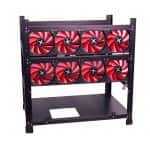The world of cryptocurrency mining is all about making the best of what you have, and it’s safe to say that this mantra applies doubly so for those invested in the field of ASIC (Application-Specific Integrated Circuit) mining. The landscape of ASIC miners has recently seen a significant shakeup with the launch of Bitmain’s latest mining rig, the KAS Miner KS3. This ASIC miner specifically targets the kHeavyHash algorithm, utilized by the Kapspa (KAS) coin.
The KS3 is a power-packed addition to the marketplace, boasting an impressive hashrate of 8300GH/s (±10%) and power efficiency of 0.38 J/G (±10%) at 25°C, which is currently one of the best available in the industry. But what exactly does this entail for prospective miners? Let’s delve deeper into its specifications, potential risks, and overall implications for KAS coin mining.
KS3 Miner Specifications
This robust rig is designed to operate under a wide range of power supply conditions, with AC input voltage ranging from 200-240 volts and frequency range of 47-63 Hz. The networking connection is facilitated via an RJ45 Ethernet 10/100M.
The hardware stands at a sizable 430mm x 195.5mm x 290mm without packaging, and a slightly larger 570mm x 316mm x 430mm with packaging. Despite its heavyweight performance, the KS3 itself weighs just 16.1kg (net weight), making it manageable for handling and setup.
The KS3 operates optimally at temperatures between 0 and 40 degrees Celsius, and in humidity levels of 10% to 90% (non-condensing). The rig is also designed to function at altitudes of up to 2000m.
A Word of Caution
While the Antminer KS3 appears to be a promising proposition, as with any investment, it does carry certain risks. The first is the release of a newer, more efficient model. As technology evolves at a breakneck pace, ASIC miners are frequently outpaced by their successors, often resulting in decreased profitability over time.
The high price point of the KS3, currently around $50,000, also presents a significant barrier to entry. It leads to a prolonged or potentially even non-existent Return on Investment (ROI). With the possibility of competing manufacturers releasing similar performing miners like the Iceriver miner, the market could soon be flooded, diluting individual miner’s profits.
As an example, let’s consider the current daily inflation reward for the KAS coin, which is approximately $500,000. If 5,000 miners are released (which seems to be a minimum estimate), the profitability of each miner would drop from $2,000 to about $100 a day. This would push the ROI for the KS3 miner to around 500 days, assuming no changes in the market.
If we were to imagine a scenario where 10,000 miners are released into the market, profitability could potentially drop even further. In a dynamic and rapidly evolving market, it’s essential to keep in mind these considerations before making a substantial investment.
Check current KAS coin mining profitability insert the performance in calculator bellow :
Or Check the current profitability of this miner here : https://hashrate.no/asics/ks3
Final Thoughts
The Bitmain KAS Miner KS3 indeed brings impressive specifications to the table. However, the rapidly evolving landscape of cryptocurrency mining and the high entry cost make it critical for potential investors to carefully evaluate the potential risks and rewards. As always, staying informed and updated with the latest trends is key to a successful and profitable mining venture.




